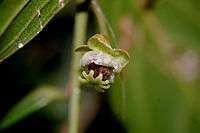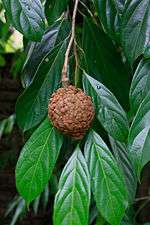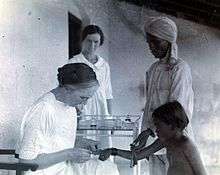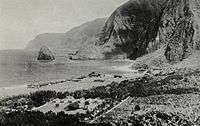Hydnocarpus wightianus
Hydnocarpus wightianus, Hydnocarpus wightiana, or chaulmoogra is a tree in the Achariaceae family. Hydnocarpus wightiana seed oil has been widely used in Indian medicine and Chinese traditional medicine for the treatment of leprosy. It entered early Western medicine in the nineteenth century before the era of sulfonamides and other antibiotics for the treatment of several skin diseases and leprosy.[2] The oil was prescribed for leprosy as a mixture suspended in gum or as an emulsion.[3][4]
| Chaulmoogra | |
|---|---|
| Scientific classification | |
| Kingdom: | Plantae |
| Clade: | Tracheophytes |
| Clade: | Angiosperms |
| Clade: | Eudicots |
| Clade: | Rosids |
| Order: | Malpighiales |
| Family: | Achariaceae |
| Genus: | Hydnocarpus |
| Species: | H. wightianus |
| Binomial name | |
| Hydnocarpus wightianus | |
Common names
Common name: Jangli almond
- Hindi: कालमोगरा Calmogara, Chalmogra, Chaulmoogra,[5] Jangli badam
- Kannada: Chalmogra yenne mara, Mirolhakai, Surti, Suranti, Toratti, Garudaphala
- Malayalam: Kodi, Maravatty, Marotti, Nirvatta, Nirvetti
- Marathi: Kadu Kawath
- Sanskrit: Tuvaraka, Turveraka, Tuvrak, कुष्टवैरी Kushtavairi
- Tamil: Maravetti, Maravattai, Marotti
- Telugu: Niradi-vittulu
Habitat
In India: It grows in tropical forests along western Ghats, along the coast from Maharashtra to Kerala, Assam, Tripura, often planted on road sides in hilly areas.
Other countries: The tree is found in South East Asia, chiefly in the Indo-Malayan region, and cultivated in Sri Lanka, Nigeria and Uganda.[6]
Morphology
This is a semi-deciduous tree which grows up to 10 m (33 ft) tall. Bark is brownish, fissured; blaze pinkish. Branch lets are round, minutely velvet-hairy. Leaves are simple, alternate, carried on 0.7–2.2 cm (0.28–0.87 in) long stalks. Leaves are 8 cm–23 cm × 3.5 cm–10 cm (3.1 in–9.1 in × 1.4 in–3.9 in), usually oblong to elliptic-oblong, tip long-pointed, often falling off, base narrow, margin toothed, papery, hairless. Midrib is raised above, secondary nerves 5−7 pairs. Its flowers have greenish white petals and are borne in short cymes or racemes, or sometimes appear by themselves in leaf axils. The flowering takes place from to January to April. Its berries are woody, round, tomentose, about 6–10 cm (2.4–3.9 in) in diameter, and start off black when young but become brown when they mature. They have numerous seeds.[5][6]
Trees of the species that yield Chaulmoogra oil grow to a height of 12–15 m (39–49 ft) and in India trees bear fruits in August and September. The fruits are ovoid some 10 cm (3.9 in) in diameter with a thick woody rind. Internally they contain 10-16 black seeds embedded in the fruit pulp. The seeds account for some 20% of the fruit weight. A typical tree produces 20 kg (44 lb) of seed/annum. The kernels make up 60−70% of the seed weight and contain 63% of pale yellow oil (mukherjee).
Chaulmoogra oil



The oil from the seeds of Hydnocarpus wightianus (Chaulmoogra) has been widely used in Indian and Chinese traditional medicine for the treatment of leprosy. It entered early Western medicine in the 19th-century before the era of sulfones and antibiotics for the treatment of several skin diseases and leprosy.[7]
Physical characteristics and composition
The oil is semi-solid at room temperature and does not have a strong odor. Gas–liquid chromatography analysis has shown the oil to contain the following fatty acids – hydnocarpic acid, chaulmoogric acid, gorlic acid, lower cyclic homologues, myristic acid, palmitic acid, stearic acid, palmitoleic acid, oleic acid, linoleic acid and linolenic acid.[8] The oil is unusual in not being made up of straight chain fatty acids but acids with a cyclic group at the end of the chain.[9]
The crude oil is of pale greenish-brown tinged. The oil can be easily into white, watery oil. The oil contains three cyclopentene fatty acids.
Table: fatty acid composition of oil[10]
| Acid | H. kurzil | H. wightiana | H. odorata |
| Hydnocarpic acid | 23.0 | 22.9 | .. |
| Chaulmoogri acid | 19.6 | 35.0 | .. |
| Gloric acid | 25.1 | 12.8 | .. |
| Lower cyclic homologs | 0.3 | 4.6 | .. |
| Myristic acid (C14:0) | 0.6 | 0.8 | 0.4 |
| Palmitic acid (C16:0) | 8.4 | 5.6 | 11.8 |
| Stearic acid (C18:0) | 1.6 | 4.7 | .. |
| Palmitoleic acid (C16:1) | 6.0 | 0.5 | |
| Oleic acid (C18:1) | 5.4 | 3.6 | 21.8 |
| Linoleic acid (C18:2) | 1.6 | 1.8 | 29.3 |
| Linolenic acid (C18:3) | .. | .. | 31.2 |
Table of physical properties of oil[11]
| Property | Range |
| Refractive index, at 400C | 1.472-1.476 |
| Iodine value | 98-103 |
| Saponification value | 198-204 |
| Acid value | Max. 25.0% |
| Melting point | 20-25 °C |
| Specific gravity (at 25 °C) | 0.950-.960 |
Extraction
Seeds are ovoid, irregular and angular, 1 to 1 1/4 inches long, 1 inch wide, skin smooth, grey, brittle; kernel oily and dark brown. A fatty oil is obtained by expression, known officially as Gynocardia oil in Britain, as Oleum Chaulmoograe in the U.S.[12]
Fruits are plucked by climbing the tree or using long sticks with a sickle tied to it. The fruits are peeled by knife and the seeds are washed in water and then dried in sun. Seeds are decorticated (dehusked) by mallet, hand hammer, or decoricator. They may also be crushed in an expeller and rotary. The kernels yield 43% oil. The extracted oil is stored in zinc barrels until exported.[6]
Leprosy
Chaulmoogra oil was commonly used in the early 20th century for the treatment of leprosy, used as intravenous injections.
The active ingredient that produces antimicrobial activity has been identified as hydnocarpic acid, a lipophilic compound. It acts by being an antagonist of biotin.[13] The oil was used intravenously or intramuscularly in the early part of the 20th-century against leprosy. An ethyl ester of the oil was developed by Alice Ball in 1916[14] which led to the preparation and marketing of it by Burroughs Wellcome (modern GlaxoSmithKline) in the early 1920s. The oil preparations were used intravenously for leprosy patients, often producing local reactions. The oil was often obtained directly from trees in India, Sri Lanka or Africa. Doctors would locally prepare ethyl esters to treat their patients. In June 1927, Burroughs Wellcome released the commercial preparation, sodium hydnocarpate marketed as Alepol, which produced lesser disagreeable symptoms of pain, swelling, irritating cough and blocking of the veins. In May 1928, doctors reported cure of leprosy in some patients after treatment with alepol.[15] In the 1940s chaulmoogra oil was replaced by the more effective sulfones.[14]
The oil contains 5′-methoxyhydnocarpin, an amphipathic weak acid, and isohydnocarpin.[16] Although a minor component in the oil with no antimicrobial activity on its own, it plays a role in preventing multidrug resistance among some bacteria such as Staphylococcus aureus. It enhances the action of berberine (which is not found in chaulmoogra oil) by preventing its removal from within Staphylococcus aureus bacterial cells. Thus using the oil or an extract of the hydnocarpic acid in combination with extracts from other plants could help increase antimicrobial activity due to synergistic effects.[17]
In view of its anti-mycobacterial activity, in 1922 it was also experimentally tried on other conditions caused by mycobacteria such as tuberculous laryngitis.[18]
See also
References
- Rumphia 4: 22. 1849. See IPNI [late Oct 1849]
- Norton, SA (October 1994). "Useful plants of dermatology. I. Hydnocarpus and chaulmoogra". Journal of the American Academy of Dermatology. 31 (4): 683–6. doi:10.1016/s0190-9622(08)81744-6. PMID 8089304.
- Cottle, Wyndham (June 28, 1879). "Chaulmoogra Oil in Leprosy". The British Medical Journal. 1 (965): 968–969. doi:10.1136/bmj.1.965.968. JSTOR 25251370. PMC 2239681. PMID 20749243.
- Parascandola, J (2003). "Chaulmoogra oil and the treatment of leprosy". Pharmacy in History. 45 (2): 47–57. CiteSeerX 10.1.1.2.164. PMID 12894769.
- "Hydnocarpus pentandrus - Jangli Almond". Flowersofindia.net. Retrieved 2013-11-21.
- SEA HandBook, 2009 by the Solvent Extractors' Association Of India
- Norton, SA (October 1994). "Useful plants of dermatology. I. Hydnocarpus and chaulmoogra". Journal of the American Academy of Dermatology. 31 (4): 683–6. doi:10.1016/s0190-9622(08)81744-6. PMID 8089304.
- Sengupta, A.; Gupta, J. K.; Dutta, J.; Ghosh, A. (1 June 1973). "The component fatty acids of chaulmoogra oil". Journal of the Science of Food and Agriculture. 24 (6): 669–674. doi:10.1002/jsfa.2740240606. PMID 4737104.
- "Minor oil crops - Individual monographs (Allanblackia-Almond-Chaulmoogra-Cuphea spp.-Jatropa curgas)". Fao.org. Retrieved 2013-11-21.
- Sengupta, A.; Gupta, J. K.; Dutta, J.; Ghosh, A. (Jun 1973). "The component fatty acids of chaulmoogra oil". J Sci Food Agric. 24 (6): 669–74. doi:10.1002/jsfa.2740240606. PMID 4737104.
- Singh, Rita (2001). Encyclopaedic Dictionary of Bio-Medecine - Rita Singh - Google Books. ISBN 9788176252423. Retrieved 2013-11-21.
- "A Modern Herbal | Chaulmoogra". Botanical.com. Retrieved 2013-11-21.
- Jacobsen, PL; Levy, L (March 1973). "Mechanism by which hydnocarpic acid inhibits mycobacterial multiplication". Antimicrobial Agents and Chemotherapy. 3 (3): 373–9. doi:10.1128/aac.3.3.373. PMC 444418. PMID 4799554.
- Mendheim, Beverly (September 2007). "Lost and Found: Alice Augusta Ball, an Extraordinary Woman of Hawai'i Nei". Northwest Hawaii Times. Retrieved 20 May 2013.
- Simpkin, Alice (December 1928). "The Treatment of Leprosy". British Journal of Nursing: 313–4. Archived from the original on 25 April 2012. Retrieved 22 October 2011.
- Ranganathan, KR; Seshadri TR (1974). "Constitution of isohydnocarpin isolated from the seed hulls of Hydnocarpus wightiana". Indian Journal of Chemistry. 12: 993.
- Stermitz, F. R. (3 February 2000). "Synergy in a medicinal plant: Antimicrobial action of berberine potentiated by 5'-methoxyhydnocarpin, a multidrug pump inhibitor". Proceedings of the National Academy of Sciences. 97 (4): 1433–1437. Bibcode:2000PNAS...97.1433S. doi:10.1073/pnas.030540597. PMC 26451. PMID 10677479.
- Lukens, RM (1922). "Chaulmoogra Oil in the Treatment of Tuberculous Laryngitis". JAMA. 78 (4): 274–275. doi:10.1001/jama.1922.02640570018009.
